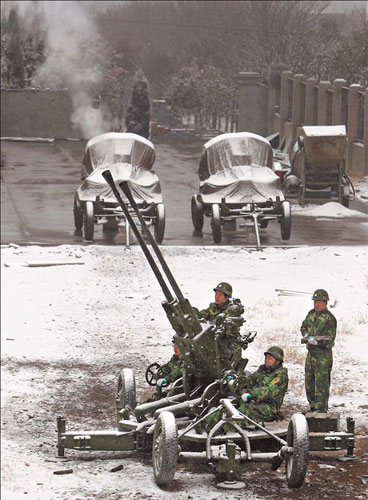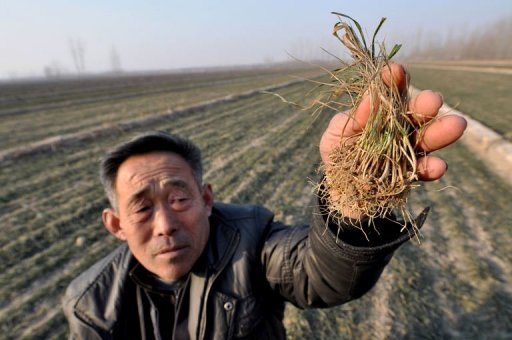Drought-hit China drills wells to save wheat crop – $1 billion earmarked for drought relief – Wheat prices hit historic high
Beijing, 11 February 2011 (AP) — China says it is launching a massive well drilling operation to save the crucial wheat crop stricken by the worst drought in decades.
The plan to drill 1,350 wells across eight northeastern provinces follows the announcement of plans to spend $1 billion to alleviate the drought. China is the world’s largest wheat growing nation. Expected shortages of the crop in China have already pushed up global prices for the commodity. The government’s Office of State Flood Control and Drought Relief Headquarters said Friday that as of Thursday afternoon, 17 million acres (6.75 million hectares) of crops had been affected by drought. Nearly 3 million people are short of drinking water. China’s wheat belt has gotten virtually no precipitation since October.
Drought-hit China drills wells to save wheat crop 
The government will spend $1 billion to battle the drought plaguing huge areas in the north, as wheat prices continued their climb and the UN warned of serious consequences for the winter harvest. The drought is the worst in six decades in many areas, and has left a swathe of grain-producing regions reeling from a lack of any significant rainfall in more than three months. The government will spend at least 6.7 billion yuan ($1.02 billion) to divert water to affected areas, construct emergency wells and irrigation facilities, and take other measures, the State Council, or the Cabinet, said in a statement on Wednesday after an executive meeting chaired by Premier Wen Jiabao. The move was included in a 10-measure package to spur grain production and tackle the persisting drought, which poses a grave threat to wheat production. The State Council also decided to pay crop-growers higher prices for their produce to offset damage to their yield in the drought-stricken areas. Wheat is generally grown in the north, while rice is primarily cultivated in the wetter south. The State Council warned the situation could worsen, saying rainfall across northern China for the foreseeable future would remain “persistently below normal levels and major rivers will continue to be generally dry”. Some 2.57 million people and 2.79 million livestock are suffering from drinking water shortages, official figures showed. The UN’s Food and Agriculture Organization (FAO) also issued a warning on Tuesday over the impact on the winter wheat crop. “The ongoing drought is potentially a very serious problem,” the Rome-based agency said. Eight major grain-producing provinces, including Shandong, Jiangsu, Henan, Hebei and Shanxi, have been affected. Together they produce more than 80 percent of China’s winter wheat. The situation in the regions could become critical if temperatures dropped further this month and a spring drought followed the winter one, the FAO said. By Wednesday, a total of 7.8 million hectares of winter wheat had been affected by the drought in the eight provinces, accounting for 42.4 percent of their total wheat-sown area, according to the Ministry of Agriculture. Concerns about the impact of the drought sent wheat prices on the Zhengzhou Commodity Exchange soaring nearly across the board on Wednesday. Prices of a key contract had hit a “historic high” of 2,865 yuan per ton on Tuesday, the Chinese finance website Hexun reported, without specifying. …
$1 Bln Earmarked for Drought Relief 
By Xiao Yu, Bloomberg News; editors: Andrew Janes, Joe Schneider
Feb 12, 2011 Snowfalls and enhanced irrigation in major wheat-growing regions have had only a “limited” effect on alleviating the dry conditions in China, the country’s drought relief agency said. The dry spell is likely to continue to affect more crops, as the weather is getting warmer and the winter wheat needs large amounts of water when turning green, said Chen Lei, deputy director at the State Flood Control and Drought Relief Headquarters, in a statement posted on its website yesterday. “China still faces an arduous task of fighting drought,” he said. “Enhanced efforts of irrigation, recent rain and snowfalls helped curb the spreading of drought in some winter- wheat growing areas.” China, the world’s biggest grains consumer, will spend 12.9 billion yuan ($2 billion) to fight drought and boost grain production, China Central Television said on Feb. 10, citing Premier Wen Jiabao. About 42 percent of the total area planted with wheat in China’s eight major producing provinces has been hurt by the dry spell that may last into the spring, Minister of Agriculture Han Changfu said last week. As of 3 p.m. Feb. 10, the drought had affected 6.75 million hectares of crops, leaving 2.8 million people and more than 2.5 million livestock short of drinking water, state-run Xinhua News Agency said yesterday. Rain on the North China Plain has been “substantially” below-normal since October, the UN Food and Agriculture Organization said on Feb. 8. Drought could force China, largely self-sufficient in wheat, to buy more from overseas, Jason Britt, the president of Central States Commodities Inc., a broker in Kansas City, Missouri, said on Feb. 10. Speculation production will be cut has pushed wheat prices in Chicago, the global benchmark, to the highest level in more than two years and prices in China to a record. Snow has fallen in drought-hit provinces including Hebei, Shanxi, Henan, Shandong, Jiangsu and Anhui since Feb. 9, which will help relieve dryness, according to the National Meteorological Center. Henan, the top-producing province, had an average of 5.5 millimeters of snow and some areas got as much as 23 millimeters, the province’s weather agency said. The provinces hit hardest by the drought are Shandong, Jiangsu, Henan, Hebei and Shanxi. Together, they accounted for 67 percent of Chinese wheat production in 2009, the FAO said on Feb. 8. China has 14 million hectares planted with winter wheat in those provinces, of which about 5.2 million hectares may have been damaged, it said. China will consume about 17 percent of the world’s wheat in the year through June, according to data from the London-based International Grains Council. The country’s output may have dropped to 114.5 million tons at the last harvest from 115.1 million tons a year earlier, the U.S. Department of Agriculture estimates. Macquarie Group Ltd. said it expects output to drop a further 4 million tons this year.
Fighting China Drought Still Arduous Task Even as Snow Falls, Agency Says
The central government of the People’s Republic of China has already spent 4 billion yuan for grain production and rural water conservation projects as a result of water shortages in the country. Since September of last year, China has received only 15 percent of the annual rainfall. The central government plans to spend an additional 2.2 billion yuan for drought relief equipment and supplies. Reports indicate that residents in China’s mountainous regions are suffering directly from the drought. Crop production has declined and residents of rural and mountainous areas are walking even longer distances to find clean drinking water. The central government also confirmed that 1.4 billion yuan would subsidize rural residents who are feeling the drought more than others. Thus far, reports indicate that 3.2 million people have been affected by the drought. But, if the drought persists into the month of March 2011, it is estimated that water supplies to one million people will cease. One million people without access to clean water supplies in a country advancing as rapidly as China seems strange. But no amount of economic growth or infrastructural development can contend with the forces of nature. …